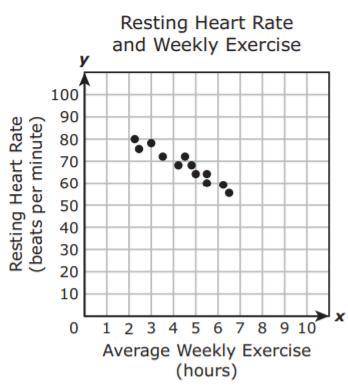
Mathematics, 15.04.2021 17:00 chasedehlin3999
Ben collected data from a group of 12 people. He measured each person’s resting heart rate and recorded the average number of hours each person exercised per week. He created a scatterplot to show the data he collected.
Based on the scatterplot, what is the best prediction of the resting heart rate, in beats per minute, of a person who exercises an average of 8 hours each week?
A. 55 beats per minute
B. 60 beats per minute
C. 50 beats per minute
D. 30 beats per minute


Answers: 2


Another question on Mathematics

Mathematics, 20.06.2019 18:02
A3x4x5 rectangular cuboid (e.g. a brick) is painted blue and cut into 1x1 cubes. what is the expected value for the painted sides of a randomly selected cube?
Answers: 1

Mathematics, 21.06.2019 17:30
One positive number is 9 more than twice another. if their product is 95, find the numbers
Answers: 1

Mathematics, 21.06.2019 18:40
The table shows the results of three plays in a football game. what is the net result of the three plays? football game 1st play 5 yards 2nd play -9 yards 3rd play 12 yards
Answers: 2

Mathematics, 21.06.2019 23:30
In a study of the relationship between socio-economic class and unethical behavior, 129 university of california undergraduates at berkeley were asked to identify themselves as having low or high social-class by comparing themselves to others with the most (least) money, most (least) education, and most (least) respected jobs. they were also presented with a jar of individually wrapped candies and informed that the candies were for children in a nearby laboratory, but that they could take some if they wanted. after completing some unrelated tasks, participants reported the number of candies they had taken. it was found that those who were identiď¬ed as upper-class took more candy than others. in this study, identify: (a) the cases, (b) the variables and their types, (c) the main research question, (d) identify the population of interest and the sample in this study, and (e) comment on whether or not the results of the study can be generalized to the population, and if the ď¬ndings of the study can be used to establish causal relationships.
Answers: 2
You know the right answer?
Ben collected data from a group of 12 people. He measured each person’s resting heart rate and recor...
Questions




Mathematics, 07.03.2021 18:40



Spanish, 07.03.2021 18:40

Geography, 07.03.2021 18:40


Mathematics, 07.03.2021 18:40


Mathematics, 07.03.2021 18:40


Computers and Technology, 07.03.2021 18:40

Chemistry, 07.03.2021 18:40

Health, 07.03.2021 18:40

Chemistry, 07.03.2021 18:40


Mathematics, 07.03.2021 18:40



